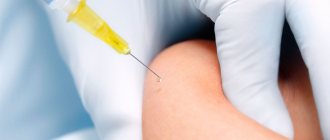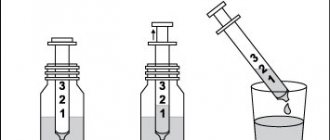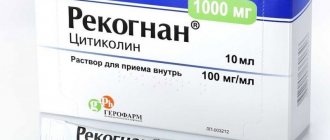Mexidol injection solution 5% 2ml amp 20 pcs
IM or IV (stream or drip). When administered by infusion, the drug should be diluted in 0.9% sodium chloride solution. Mexidol® is administered slowly over 5–7 minutes in a stream, and dropwise at a rate of 40–60 drops per minute. The maximum daily dose should not exceed 1200 mg.
For acute cerebrovascular accidents, Mexidol® is used in the first 10–14 days - 200–500 mg IV drip 2–4 times a day, then 200–250 mg IM 2–3 times a day for 2 weeks .
For traumatic brain injury and the consequences of traumatic brain injuries, Mexidol® is used for 10-15 days intravenously at a dose of 200–500 mg 2–4 times a day.
For dyscirculatory encephalopathy in the decompensation phase, Mexidol® should be prescribed intravenously in a stream or drip at a dose of 200–500 mg 1–2 times a day for 14 days. Then IM 100–250 mg/day over the next 2 weeks.
For a course of prophylaxis of discirculatory encephalopathy, the drug is administered intramuscularly at a dose of 200–250 mg 2 times a day for 10–14 days.
For mild cognitive impairment in elderly patients and anxiety disorders, the drug is used intramuscularly at a daily dose of 100–300 mg/day for 14–30 days.
In case of acute myocardial infarction, as part of complex therapy, Mexidol® is administered intravenously or intramuscularly for 14 days, against the background of traditional therapy for myocardial infarction, including nitrates, beta-blockers, angiotensin-converting enzyme (ACE) inhibitors, thrombolytics, anticoagulant and antiplatelet agents, as well as symptomatic means according to indications.
In the first 5 days, to achieve maximum effect, it is advisable to administer the drug intravenously; in the next 9 days, Mexidol® can be administered intramuscularly.
Intravenous administration of the drug is carried out by drip infusion, slowly (to avoid side effects) in a 0.9% sodium chloride solution or 5% dextrose (glucose) solution in a volume of 100–150 ml for 30–90 minutes. If necessary, a slow jet injection of the drug, lasting at least 5 minutes, is possible.
The drug is administered (intravenous or intramuscular) 3 times a day, every 8 hours. The daily therapeutic dose is 6-9 mg/kg body weight per day, a single dose is 2-3 mg/kg body weight. The maximum daily dose should not exceed 800 mg, single dose - 250 mg.
For open-angle glaucoma of various stages, as part of complex therapy, Mexidol® is administered intramuscularly at 100–300 mg/day, 1–3 times a day for 14 days.
For alcohol withdrawal syndrome, Mexidol® is administered in a dose of 200–500 mg intravenously or intramuscularly 2–3 times a day for 5–7 days.
In case of acute intoxication with antipsychotic drugs, the drug is administered intravenously at a dose of 200-500 mg/day for 7-14 days. In acute purulent-inflammatory processes of the abdominal cavity (acute necrotizing pancreatitis, peritonitis), the drug is prescribed on the first day both in the preoperative and postoperative periods. The administered doses depend on the form and severity of the disease, the prevalence of the process, and variants of the clinical course. The drug should be discontinued gradually only after a stable positive clinical and laboratory effect.
For acute edematous (interstitial) pancreatitis, Mexidol® is prescribed 200–500 mg 3 times a day, intravenously (in 0.9% sodium chloride solution) and intramuscularly. Mild severity of necrotizing pancreatitis - 100-200 mg 3 times a day intravenously (in 0.9% sodium chloride solution) and intramuscularly. Moderate severity - 200 mg 3 times a day intravenously (in 0.9% sodium chloride solution). Severe course - in a pulse dosage of 800 mg on the first day with a double dose regimen; then 200–500 mg 2 times a day with a gradual reduction in the daily dose. Extremely severe course - at an initial dosage of 800 mg/day until the manifestations of pancreatogenic shock are persistently relieved, after stabilization of the condition, 300-500 mg 2 times a day intravenously (in 0.9% sodium chloride solution) with a gradual decrease in the daily dosage.
Mexidol 50 mg/ml 5ml No. 5 solution d/in.amp. i.v. and i.m.
Instructions for medical use of the drug MEXIDOL® Trade name Mexidol® International nonproprietary name No Dosage form Solution for intravenous and intramuscular administration 50 mg/ml, 2 ml or 5 ml Composition 1 ml of solution contains the active substance - ethylmethylhydroxypyridine succinate 50 mg, excipients: sodium metabisulfite, water for injection Description Transparent colorless or slightly yellowish liquid Pharmacotherapeutic group Other drugs for the treatment of diseases of the nervous system. ATC code N07XX Pharmacological properties Pharmacokinetics When administered intramuscularly, the drug is determined in the blood plasma for 4 hours after administration. The time to reach maximum concentration is 0.45-0.50 hours. The maximum concentration at doses of 400-500 mg is 3.5-4.0 mcg/ml. Mexidol® quickly passes from the bloodstream into organs and tissues and is quickly eliminated from the body. The retention time (MRT) of the drug in the body is 0.7-1.3 hours. The drug is excreted from the body in the urine mainly in glucurone-conjugated form and in small quantities unchanged. Pharmacodynamics Mexidol® has antihypoxic, membrane-protective, nootropic, anticonvulsant, anxiolytic effects, and increases the body's resistance to stress. Mexidol® increases the body's resistance to the effects of major damaging factors, to oxygen-dependent pathological conditions (shock, hypoxia and ischemia, cerebrovascular accident, intoxication with alcohol and antipsychotic drugs (neuroleptics). Mexidol® improves cerebral metabolism and blood supply to the brain, improves microcirculation and rheological properties blood, reduces platelet aggregation. Stabilizes the membrane structures of blood cells (erythrocytes and platelets) during hemolysis. Has a hypolipidemic effect, reduces the level of total cholesterol and low-density lipoproteins (LDL). Reduces enzymatic toxemia and endogenous intoxication in acute pancreatitis. The mechanism of action of Mexidol® is determined by its antihypoxic, antioxidant and membrane protective effects.It inhibits the processes of lipid peroxidation, increases the activity of superoxide oxidase, increases the lipid-protein ratio, reduces membrane viscosity, and increases its fluidity. Modulates the activity of membrane-bound enzymes (calcium-independent phosphodiesterase, adenylate cyclase, acetylcholinesterase), receptor complexes (benzodiazepine, gamma-aminobutyric acid (GABA), acetylcholine), which enhances their ability to bind to ligands, helps preserve the structural and functional organization of biomembranes, transport of neurotransmitters and improve synaptic transfers. Mexidol® increases dopamine levels in the brain. Causes an increase in the compensatory activity of aerobic glycolysis and a decrease in the degree of inhibition of oxidative processes in the Krebs cycle under hypoxic conditions, with an increase in the content of adenosine triphosphate (ATP), creatine phosphate and activation of the energy-synthesizing functions of mitochondria, stabilization of cell membranes. Indications for use - acute cerebrovascular accidents - dyscirculatory encephalopathy - vegetative-vascular dystonia - mild cognitive disorders of atherosclerotic origin - anxiety disorders in neurotic and neurosis-like conditions - relief of withdrawal syndrome in alcoholism with a predominance of neurosis-like and vegetative-vascular disorders - acute intoxication with antipsychotic drugs - acute purulent-inflammatory processes of the abdominal cavity (acute necrotizing pancreatitis, peritonitis) as part of complex therapy. Method of administration and dosage The drug Mexidol® is prescribed intramuscularly or intravenously (stream or drip). When administered by infusion, the drug should be diluted in physiological sodium chloride solution. The drug is administered slowly over 5-7 minutes in a stream, and dropwise at a rate of 40-60 drops per minute. The maximum daily dose should not exceed 1200 mg. In case of acute cerebrovascular accidents, the drug is used in complex therapy in the first 10-14 days - 200-500 mg intravenously 2-4 times a day, then intramuscularly 200-250 mg 2-3 times a day for 2 weeks. For dyscirculatory encephalopathy in the decompensation phase, the drug should be prescribed intravenously in a stream or drip at a dose of 200-500 mg 1-2 times a day for 14 days. Then the drug is administered intramuscularly at 100-250 mg per day over the next 2 weeks. For a course of prophylaxis of dyscirculatory encephalopathy, the drug is administered intramuscularly at a dose of 200-250 mg 2 times a day for 10-14 days. For mild cognitive impairment in elderly patients and anxiety disorders, the drug is used intramuscularly in a daily dose of 100-300 mg per day for 14-30 days. For alcohol withdrawal syndrome, the drug is administered in a dose of 200-500 mg intravenously or intramuscularly 2-3 times a day for 5-7 days. In case of acute intoxication with antipsychotic drugs, the drug is administered intravenously at a dose of 50-300 mg per day for 7-14 days. In case of acute purulent-inflammatory processes of the abdominal cavity (acute necrotizing pancreatitis, peritonitis), the drug is prescribed on the first day, both in the preoperative and postoperative periods. The administered doses depend on the form and severity of the disease, the prevalence of the process, and variants of the clinical course. The drug should be discontinued gradually only after a positive therapeutic effect. For acute edematous (interstitial) pancreatitis, the drug is prescribed 200-500 mg 3 times a day, intravenously (in isotonic sodium chloride solution) and intramuscularly. Mild severity of necrotizing pancreatitis - 100-200 mg 3 times a day intravenously (in isotonic sodium chloride solution) and intramuscularly. Moderate severity - 200 mg 3 times a day, intravenously (in isotonic sodium chloride solution). Severe cases - in a pulse dosage of 800 mg on the first day, with a double administration regimen, then 200-500 mg 2 times a day with a gradual decrease in the daily dose. Extremely severe course - at an initial dosage of 800 mg per day until the manifestations of pancreatogenic shock are persistently relieved, after stabilization of the condition, 300-500 mg 2 times a day intravenously (in isotonic sodium chloride solution) with a gradual decrease in the daily dosage. Side effects - nausea and dry mouth, metallic taste in the mouth - drowsiness - allergic reactions - unpleasant odor, sore throat and chest discomfort Contraindications - increased individual sensitivity to the drug - acute disorders of the liver and kidneys - childhood and adolescence up to 18 years - pregnancy, lactation period Drug interactions Enhances the effect of benzodiazepine anxiolytics, anticonvulsants (carbamazepine), antiparkinsonian drugs (levodopa), nitrates. Reduces the toxic effects of ethyl alcohol. Special instructions In some cases, especially in predisposed patients with bronchial asthma with increased sensitivity to sulfites, severe hypersensitivity reactions may develop. Features of the drug's influence on the ability to drive vehicles and potentially dangerous mechanisms Care should be taken when driving vehicles and potentially dangerous mechanisms. Overdose Symptoms: increased side effects. Treatment: the drug is temporarily discontinued. Symptomatic treatment. Release form and packaging Solution 50 mg/ml in ampoules of 2 ml or 5 ml, colorless or light-protective glass with a blue break point or a white break point and three marking rings (top - yellow, middle - white, bottom - red) . 5 ampoules each in a blister pack made of polyvinyl chloride film without aluminum foil coating. 1 (for ampoules of 5 ml) or 2 (for ampoules of 2 ml) blister packs together with instructions for medical use are placed in a cardboard pack. Storage conditions Store in a dry place, protected from light, at a temperature not exceeding 25ºС. Keep out of the reach of children! Shelf life 3 years Do not use after the expiration date indicated on the package. Conditions for dispensing from pharmacies By prescription under license from NPK Pharmasoft LLC Address: Russia, 352212, Krasnodar region, Novokubansky district, Progress village, st. Mechnikova, 11 Organization that accepts complaints from consumers regarding the quality of products (products) LLC NPK Pharmasoft Russia, 115280, Moscow, st. Avtozavodskaya, 22. Tel./fax: (495)-626-47-48 E-mail: pharmasoft @pharmasoft.ru
Mexidol, ampoules 5%, 2 ml, 10 pcs.
Manufacturer
Pharmasoft, Russia
Compound
Active ingredient:
ethylmethylhydroxypyridine succinate 50 mg;
Excipients:
sodium metabisulfite - 0.4 mg,
water for d/i - up to 1 ml.
pharmachologic effect
Pharmacodynamics
Mexidol® has antihypoxic, membrane protective, nootropic, anticonvulsant, anxiolytic effects, and increases the body's resistance to stress. The drug increases the body's resistance to the effects of major damaging factors, to oxygen-dependent pathological conditions (shock, hypoxia and ischemia, cerebrovascular accident, intoxication with alcohol and antipsychotic drugs (neuroleptics)).
Mexidol® improves cerebral metabolism and blood supply to the brain, improves microcirculation and rheological properties of blood, and reduces platelet aggregation. Stabilizes the membrane structures of blood cells (erythrocytes and platelets) during hemolysis. It has a hypolipidemic effect, reduces the level of total cholesterol and LDL. Reduces enzymatic toxemia and endogenous intoxication in acute pancreatitis.
The mechanism of action of Mexidol® is due to its antihypoxic, antioxidant and membrane protective effects. It inhibits the processes of lipid peroxidation, increases the activity of superoxide dismutase, increases the lipid-protein ratio, reduces membrane viscosity, and increases its fluidity. Modulates the activity of membrane-bound enzymes (calcium-independent phosphodiesterase, adenylate cyclase, acetylcholinesterase), receptor complexes (benzodiazepine, GABA, acetylcholine), which enhances their ability to bind to ligands, helps preserve the structural and functional organization of biomembranes, transport of neurotransmitters and improve synaptic transmission. Mexidol® increases dopamine levels in the brain. Causes an increase in the compensatory activity of aerobic glycolysis and a decrease in the degree of inhibition of oxidative processes in the Krebs cycle under hypoxic conditions, with an increase in the content of ATP, creatine phosphate and activation of the energy-synthesizing functions of mitochondria, stabilization of cell membranes.
Mexidol® normalizes metabolic processes in the ischemic myocardium, reduces the necrosis zone, restores and improves the electrical activity and contractility of the myocardium, and also increases coronary blood flow in the ischemic zone, reduces the consequences of reperfusion syndrome in acute coronary insufficiency. Increases the antianginal activity of nitro drugs.
Mexidol® promotes the preservation of retinal ganglion cells and optic nerve fibers during progressive neuropathy, the causes of which are chronic ischemia and hypoxia. Improves the functional activity of the retina and optic nerve, increasing visual acuity.
Pharmacokinetics
Suction
When Mexidol® is administered in doses of 400-500 mg, Cmax in plasma is 3.5-4.0 mcg/ml and is achieved within 0.45-0.5 hours.
Distribution
After intramuscular administration, the drug is determined in the blood plasma within 4 hours. The average retention time of the drug in the body is 0.7-1.3 hours.
Removal
It is excreted from the body in the urine mainly in glucurone-conjugated form and in small quantities unchanged.
Indications
- acute cerebrovascular accidents;
- traumatic brain injury, consequences of traumatic brain injury;
- encephalopathy;
- autonomic dystonia syndrome;
- mild cognitive disorders of atherosclerotic origin;
- anxiety disorders in neurotic and neurosis-like conditions;
- acute myocardial infarction (from the first day) as part of complex therapy;
- primary open-angle glaucoma of various stages, as part of complex therapy;
- relief of withdrawal syndrome in alcoholism with a predominance of neurosis-like and vegetative-vascular disorders;
- acute intoxication with antipsychotic drugs;
- acute purulent-inflammatory processes of the abdominal cavity (acute necrotizing pancreatitis, peritonitis) as part of complex therapy.
Contraindications
- increased individual sensitivity to the drug;
- acute dysfunction of the liver and kidneys.
Strictly controlled clinical studies of the safety of the drug Mexidol® in children, pregnancy and breastfeeding have not been conducted.
Side effects
From the digestive system: rarely - nausea, dry mouth.
Other: rarely - allergic reactions.
Interaction
When used together, Mexidol® enhances the effect of benzodiazepine derivative anxiolytics, antiparkinsonian (levodopa) and anticonvulsant (carbamazepine) drugs.
Mexidol® reduces the toxic effect of ethyl alcohol.
How to take, course of administration and dosage
IM or IV (stream or drip). When administered by infusion, the drug should be diluted in 0.9% sodium chloride solution.
Mexidol® is administered in a stream slowly over 5–7 minutes, and dropwise at a rate of 40–60 drops per minute. The maximum daily dose should not exceed 1200 mg.
For acute cerebrovascular accidents, Mexidol® is used in the first 10-14 days - 200-500 mg intravenously 2-4 times a day, then 200-250 mg intramuscularly 2-3 times a day for 2 weeks .
For traumatic brain injury and the consequences of traumatic brain injury, Mexidol® is used for 10–15 days intravenously at a dose of 200–500 mg 2–4 times a day.
For discirculatory encephalopathy in the decompensation phase, Mexidol® should be prescribed intravenously in a stream or drip at a dose of 200–500 mg 1–2 times a day for 14 days. Then IM 100–250 mg/day over the next 2 weeks.
For a course of prophylaxis of discirculatory encephalopathy, the drug is administered intramuscularly at a dose of 200–250 mg 2 times a day for 10–14 days.
For mild cognitive impairment in elderly patients and for anxiety disorders, the drug is used intramuscularly at a daily dose of 100–300 mg/day. for 14 – 30 days.
In case of acute myocardial infarction, as part of complex therapy, Mexidol® is administered intravenously or intramuscularly for 14 days, against the background of traditional therapy for myocardial infarction, including nitrates, beta-blockers, angiotensin-converting enzyme (ACE) inhibitors, thrombolytics, anticoagulant and antiplatelet agents, as well as symptomatic means according to indications.
In the first 5 days, to achieve maximum effect, it is advisable to administer the drug intravenously; in the next 9 days, Mexidol® can be administered intramuscularly.
Intravenous administration of the drug is carried out by drip infusion, slowly (to avoid side effects) in a 0.9% sodium chloride solution or 5% dextrose (glucose) solution in a volume of 100 - 150 ml for 30 - 90 minutes. If necessary, a slow jet injection of the drug, lasting at least 5 minutes, is possible.
The drug is administered (intravenous or intramuscular) 3 times a day, every 8 hours. The daily therapeutic dose is 6–9 mg/kg body weight per day, a single dose is 2–3 mg/kg body weight. The maximum daily dose should not exceed 800 mg, single dose - 250 mg.
For open-angle glaucoma of various stages, as part of complex therapy, Mexidol® is administered intramuscularly at 100–300 mg/day, 1–3 times a day for 14 days.
For alcohol withdrawal syndrome, Mexidol® is administered in a dose of 200–500 mg intravenously or intramuscularly 2–3 times a day for 5–7 days.
In case of acute intoxication with antipsychotic drugs, the drug is administered intravenously at a dose of 200–500 mg/day for 7–14 days.
In acute purulent-inflammatory processes of the abdominal cavity (acute necrotizing pancreatitis, peritonitis), the drug is prescribed on the first day both in the preoperative and postoperative periods. The administered doses depend on the form and severity of the disease, the prevalence of the process, and variants of the clinical course. The drug should be discontinued gradually only after a stable positive clinical and laboratory effect.
For acute edematous (interstitial) pancreatitis, Mexidol® is prescribed 200–500 mg 3 times a day, intravenously (in 0.9% sodium chloride solution) and intramuscularly. Mild severity of necrotizing pancreatitis - 100 - 200 mg 3 times a day intravenously (in 0.9% sodium chloride solution) and intramuscularly. Moderate severity - 200 mg 3 times a day, intravenously (in 0.9% sodium chloride solution). Severe course - in a pulse dosage of 800 mg on the first day, with a two-fold administration regimen; then 200–500 mg 2 times a day with a gradual reduction in the daily dose.
Extremely severe course - at an initial dosage of 800 mg/day until the manifestations of pancreatogenic shock are persistently relieved, after stabilization of the condition, 300 - 500 mg 2 times a day intravenously (in 0.9% sodium chloride solution) with a gradual decrease in the daily dosage.
Overdose
Symptoms: drowsiness may develop.
Special instructions
Mexidol can be combined with all drugs used to treat somatic diseases.
Use in pediatrics
Strictly controlled clinical studies of the safety of Mexidol® in children have not been conducted.
Impact on the ability to drive vehicles and operate machinery
During the treatment period, care must be taken when driving vehicles and engaging in other potentially hazardous activities that require increased concentration and speed of psychomotor reactions.
In some cases, especially in predisposed patients with bronchial asthma with increased sensitivity to sulfites, severe hypersensitivity reactions may develop.
Release form
Injection
Storage conditions
In a dry place, protected from light, at a temperature not exceeding 25 °C.
Best before date
2 years
Active substance
Ethylmethylhydroxypyridine succinate
Conditions for dispensing from pharmacies
On prescription
Dosage form
solution for injections and infusions
Purpose
Adults as prescribed by a doctor
Indications
From a hangover, When exposed to adverse factors, From atherosclerosis, From angina pectoris, From cerebrovascular accidents, From concussion and other traumatic brain injuries, From the consequences of a stroke, Prevention of acute myocardial infarction, From vegetative-vascular disorders
Information in the State Register of Medicines
Go
Barcode and weight
Barcode: 4602676004052, 4605894001339, 4670008161469 Weight: 0.056 kg
Mexidol, 10 pcs., 2 ml, 50 mg/ml, solution for intravenous and intramuscular administration
IV (stream or drip) or IM.
When administered by infusion, the drug should be diluted in an isotonic sodium chloride solution.
Mexidol® is administered slowly over 5–7 minutes in a stream, and dropwise at a rate of 40–60 drops per minute. The maximum daily dose should not exceed 1200 mg.
For acute cerebrovascular accidents
Mexidol® is used in the first 10-14 days - 200-500 mg IV drip 2-4 times a day, then - 200-250 mg IM 2-3 times a day for 2 weeks.
For TBI and consequences of TBI
- IV drip of 200–500 mg 2–4 times a day, for 10–15 days.
For dyscirculatory encephalopathy in the decompensation phase
Mexidol® should be administered intravenously in a stream or drip at a dose of 200–500 mg 1–2 times a day for 14 days. Then - IM 100-250 mg/day over the next 2 weeks.
For course prophylaxis of dyscirculatory encephalopathy
the drug is administered intramuscularly at a dose of 200–250 mg 2 times a day for 10–14 days.
For mild cognitive impairment in elderly patients and anxiety disorders
the drug is used intramuscularly at a daily dose of 100–300 mg/day for 14–30 days.
In acute myocardial infarction as part of complex therapy
Mexidol® is administered intravenously or intramuscularly for 14 days against the background of traditional therapy for myocardial infarction, including nitrates, β-blockers, ACE inhibitors, thrombolytics, anticoagulant and antiplatelet agents, as well as symptomatic agents according to indications. In the first 5 days, to achieve maximum effect, it is advisable to administer the drug intravenously; in the next 9 days, Mexidol® can be administered intramuscularly. The drug is administered intravenously by drip infusion, slowly (to avoid side effects) in an isotonic sodium chloride solution or 5% dextrose (glucose) solution in a volume of 100–150 ml for 30–90 minutes. If necessary, slow jet administration of the drug is possible, lasting at least 5 minutes.
The drug is administered (IV or IM) 3 times a day, every 8 hours. The daily therapeutic dose is 6–9 mg/kg/day, a single dose is 2–3 mg/kg. The maximum daily dose should not exceed 800 mg, single dose - 250 mg.
For open-angle glaucoma of various stages as part of complex therapy
Mexidol® is administered intramuscularly at 100–300 mg/day, 1–3 times a day for 14 days.
For alcohol withdrawal syndrome
Mexidol® is administered in a dose of 200–500 mg intravenously or intramuscularly 2–3 times a day for 5–7 days.
In case of acute intoxication with antipsychotic drugs
the drug is administered intravenously at a dose of 200–500 mg/day for 7–14 days.
In acute purulent-inflammatory processes in the abdominal cavity (acute necrotizing pancreatitis, peritonitis)
the drug is prescribed on the first day both in the preoperative and postoperative periods. The administered doses depend on the form and severity of the disease, the prevalence of the process, and variants of the clinical course. The drug should be discontinued gradually only after a stable positive clinical and laboratory effect.
For acute edematous (interstitial) pancreatitis
Mexidol® is prescribed 200–500 mg 3 times a day intravenously (in isotonic sodium chloride solution) and intramuscularly.
Mild severity of necrotizing pancreatitis
- 100–200 mg 3 times a day intravenously (in isotonic sodium chloride solution) and intramuscularly.
Moderate severity
- 200 mg 3 times a day intravenously (in isotonic sodium chloride solution).
Severe course
- in a pulse dosage of 800 mg on the first day, with a two-fold administration regimen;
then - 200–500 mg 2 times a day with a gradual reduction in the daily dose. Extremely severe course
- at an initial dosage of 800 mg/day until the manifestations of pancreatogenic shock are persistently relieved, upon stabilization of the condition - 300-500 mg 2 times a day intravenously (in isotonic sodium chloride solution) with a gradual decrease in the daily dosage.



